Type of resources
Available actions
Topics
Keywords
Contact for the resource
Provided by
Years
Formats
Representation types
Update frequencies
status
Service types
Scale
Resolution
-
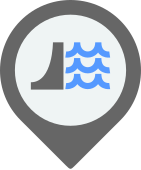
Les barrages sont à l’origine de modifications significatives du régime hydrologique, de la température de l’eau et des flux biologiques et biogéochimiques. C’est le cas des barrages de Vezins et de la Roche qui Boit, présents sur le cours principal de la Sélune, et d’autres plus petits obstacles qui fragmentent le bassin versant de la Sélune. Cette couche représente les barrages hydroélectriques de la Sélune, avec les batiments associés, en lien avec la production électrique. La géométrie de ces polygones est issue de plusieurs sources : BD Topo, OpenStreetMap (de 2019), complétée par photointerprétation. Des informations extraites du livre « Quand les rivières reprennent leur cours – Notes sur l’effacement de barrages et de seuils, sur la Sélune et ailleurs » ont été ajoutées pour décrire l'état (en service ou arasé), la nature et les caractérisques physiques de ces barrages.
-
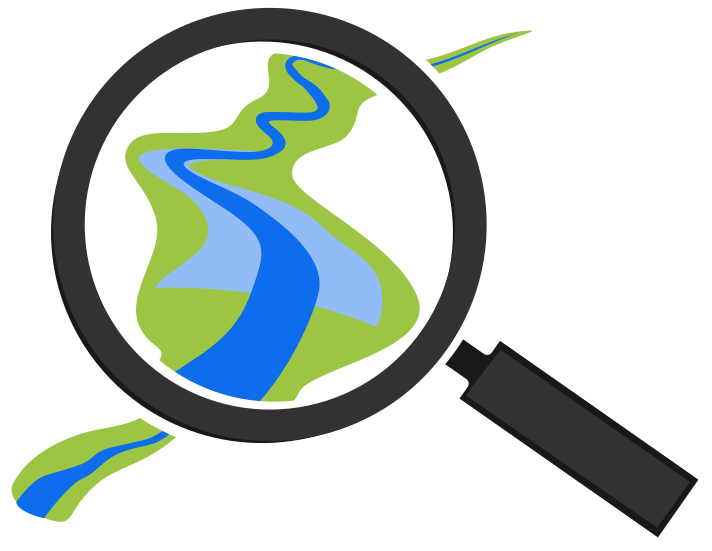
-
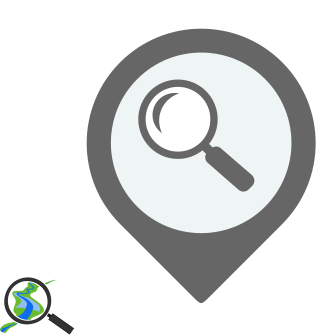
La vallée de la Sélune subit actuellement d’importants changements dans la morphologie de ses berges et de son cours d’eau. Ainsi, l’analyse des interactions entre zone aquatique et zone riveraine dans ce contexte de restauration représente une opportunité scientifique unique de compréhension des mécanismes écologiques qui sous-tendent non seulement la résilience, mais aussi le fonctionnement global des écosystèmes. Le projet « interaction entre zones aquatiques et riveraines » (RestaurE) étudie le rétablissement du fonctionnement des écosystèmes de la Sélune (résilience). Il considère les interactions entre la morphologie du fleuve, la recolonisation de l’eau et des berges par la végétation et par les espèces d’invertébrés aquatiques et terrestres. Ce projet de recherche a pour objectif d’amorcer l’analyse des néo-habitats issus de la restauration de la Sélune en se concentrant sur les interactions terrestres/aquatiques au niveau des interfaces riveraines. Il permettra ainsi de comprendre le rôle spécifique de ces interactions dans le processus de résilience des écosystèmes en restauration. L’étude des interactions entre zones aquatiques et riveraines sur la Sélune est réalisée sous deux angles : (1) Caractériser le fonctionnement bio-géo-morphologique du cours d’eau et de ses berges ; (2) Étudier le fonctionnement des réseaux trophiques (aquatiques et terrestres). Cette couche donne la localisation des secteurs d'étude utilisés dans le cadre du projet "RestaurE".
-
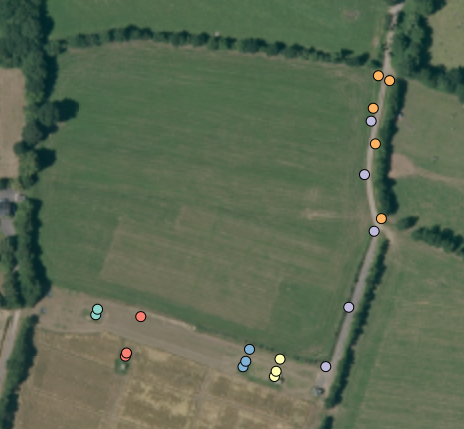
La couche des drains du Système d’Observatoires d’Expérimentations et de Recherche en Environnement (SOERE) de Produits Résiduaires Organiques (PRO) EFELE représente la position géographique des drains du dispositif du SOERE
-
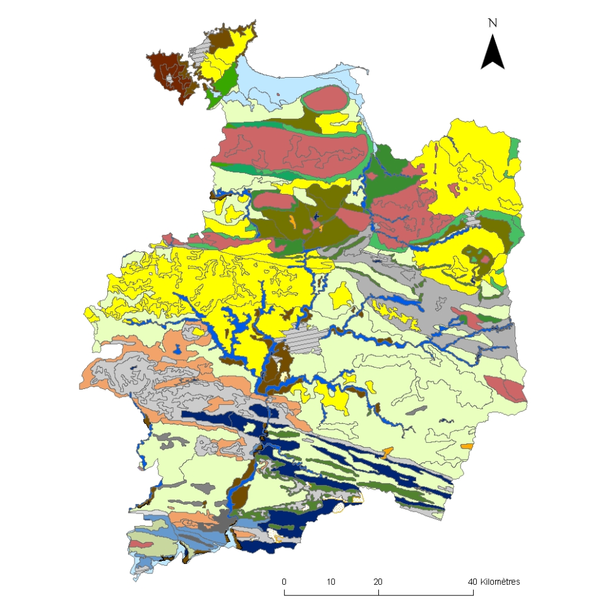
Représentation des contours des 101 unités cartographiques de sol (également appelées UCS ou pédopaysages) d'Ille-et-Vilaine. Chaque UCS, constituée d'un ou plusieurs polygones, est définie comme une portion de paysage dans laquelle les facteurs de genèse des sols (matériau parental, morphologie, climat, occupation du sol) sont homogènes. Cette couche d'information fait partie du Référentiel régional pédologique (1/250 000)
-
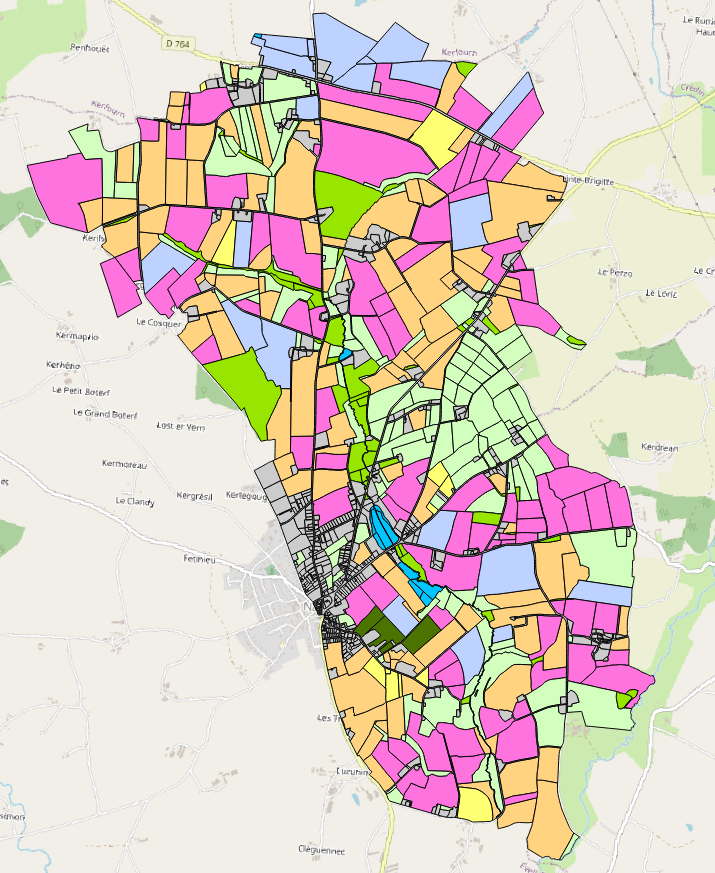
Occupation des sols 2023 du bassin versant du site de Naizin dans le Morbihan dans le cadre de l'Observatoire de Recherche en Environnement (ORE) AgrHyS d'INRAE. Le parcellaire est issu du cadastre de 2013. Les dessertes ont été redessinées à partir des orthophotos IGN de 2013 et le parcellaire a été découpé en fonction d’une zone tampon autour de ces dessertes. Les parcelles 2013 peuvent être découpées mais jamais regroupées. Toutes les entités géographiques élémentaires ont un identifiant unique sur l’ensemble des années. Champs de la table d’attribut : • ID_2023 : identifiant de la parcelle pour l’année 2023 • ID2_2023 : identifiant "bis" (lors de subdivision culturale) de la parcelle pour l'année 2023 • TYPE_23 : code principal de l’occupation des sols • S_TYPE_23 : code secondaire de l’occupation des sols • ID_PARCEL : identifiant numérique et non significatif par parcelle du RPG dernière version • CODE_GROUP : code du groupe de cultures du RPG dernière version • CODE_CULTU : code du groupe de cultures majoritaire du RPG dernière version • CULTURE_D1 : code de la culture dérobée (culture intercalée entre 2 moissons de culture principale) sur la parcelle. • CULTURE_D2 : code de la seconde culture dérobée (culture intercalée entre 2 moissons de culture principale). • SURF_PARCEL : surface en hectares de la parcelle La nomenclature de ces codes des types et sous-types a été définie dans le programme ANR-12-AGRO-0005 MOSAIC : https://anr.fr/Projet-ANR-12-AGRO-0005. Leurs descriptions peuvent être télécharger ici : https://geosas.fr/metadata/ore/xls/legendes_osol_naizin.xlsx. Les occupations des sols sont issues des données par parcelles du Registre Parcellaire Graphique (RPG) de la dernière année en cours de publication. Les limites des parcelles ont été mises en concordance avec le parcellaire de 2013.
-

Emprise de la carte pédologique de Guerche au 1/50000. La donnée de base, au format image scannée, n'est pas publiée.
-

Occupation des sols 1999 du bassin versant du site de Naizin dans le Morbihan dans le cadre de l'Observatoire de Recherche en Environnement (ORE) AgrHyS d'INRAE. Le parcellaire est issu du cadastre de 2013. Les dessertes ont été redessinées à partir des orthophotos IGN de 2013 et le parcellaire a été découpé en fonction d’une zone tampon autour de ces dessertes. Les parcelles 2013 peuvent être découpées mais jamais regroupées. Toutes les entités géographiques élémentaires ont un identifiant unique sur l’ensemble des années. Champs de la table d’attribut : • ID_1999 : identifiant de la parcelle pour l’année 1999 • TYPE : code principal de l’occupation des sols • S_TYPE : code secondaire de l’occupation des sols La nomenclature de ces codes des types et sous-types a été définie dans le programme ANR-12-AGRO-0005 MOSAIC : https://anr.fr/Projet-ANR-12-AGRO-0005. Leurs descriptions peuvent être télécharger ici : https://geosas.fr/metadata/ore/xls/legendes_osol_naizin.xlsx. Les occupations des sols sont issues de photo-interprétation dans le cadre du programme CORMORAN (Cheverry et al., 1998). Les limites des parcelles ont été mises en concordance avec le parcellaire de 2013.
-
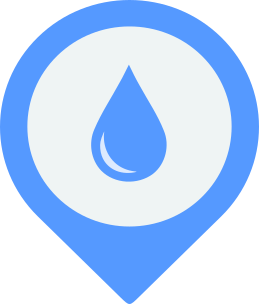
Des stations de mesure en continu de paramètres hydrologiques, physiques, chimiques et sédimentaires ont été installées sur le fleuve Sélune, dans le cadre du programme scientifique de suivi de l’arasement des barrages de la Sélune. Sur 2 d'entre elles, un suivi des concentrations en éléments chimiques a été mis en place. Des prélèvements manuels hebdomadaires ou automatiques à plus haute fréquence lors de crues sont réalisés sur ces stations. Les analyses chimiques sur ces prélèvements sont réalisées au laboratoire de l’unité mixte de recherche SAS et qui contribuent au suivi des paramètres environnementaux abiotiques, et relèvent donc de l'Observatoire Sélune. Les concentrations analysées portent sur les éléments de la phase dissoute (phosphore dissous, anions majeurs, silice dissoute, ammonium) et de la phase particulaire (matières en suspension, teneur en carbone et en azote de celles-ci, Phosphore total).
-

Les flux hydrologiques, sédimentaires fins et grossiers, et chimiques sont fortement impactés par la présence des barrages, alors que ces paramètres jouent un rôle majeur sur la qualité des habitats pour les communautés aquatiques. leur suivi sur le long terme est primordial dans le cadre d’une opération de restauration écologique après effacement de barrages. De plus sur la Sélune, le démantèlement s’accompagne d’une gestion spécifique des sédiments pour éviter un transfert massif de sédiments vers l’aval. Le transport des sédiments grossiers est étudié à l’aide de galets marqués par des transpondeurs passifs (pit tags). Ces pit tags ont été introduits dans plusieurs centaines de galets de différentes tailles du fleuve. Leurs déplacements au cours du cycle hydrologique sont suivis à l’aide d’une antenne que l’on déplace manuellement en parcourant la rivière, à raison d’une campagne par an. Cette couche donne les localisations des secteurs d'étude utilisés dans le suivi du transport des sédiments grossiers.
 Catalogue GéoSAS
Catalogue GéoSAS